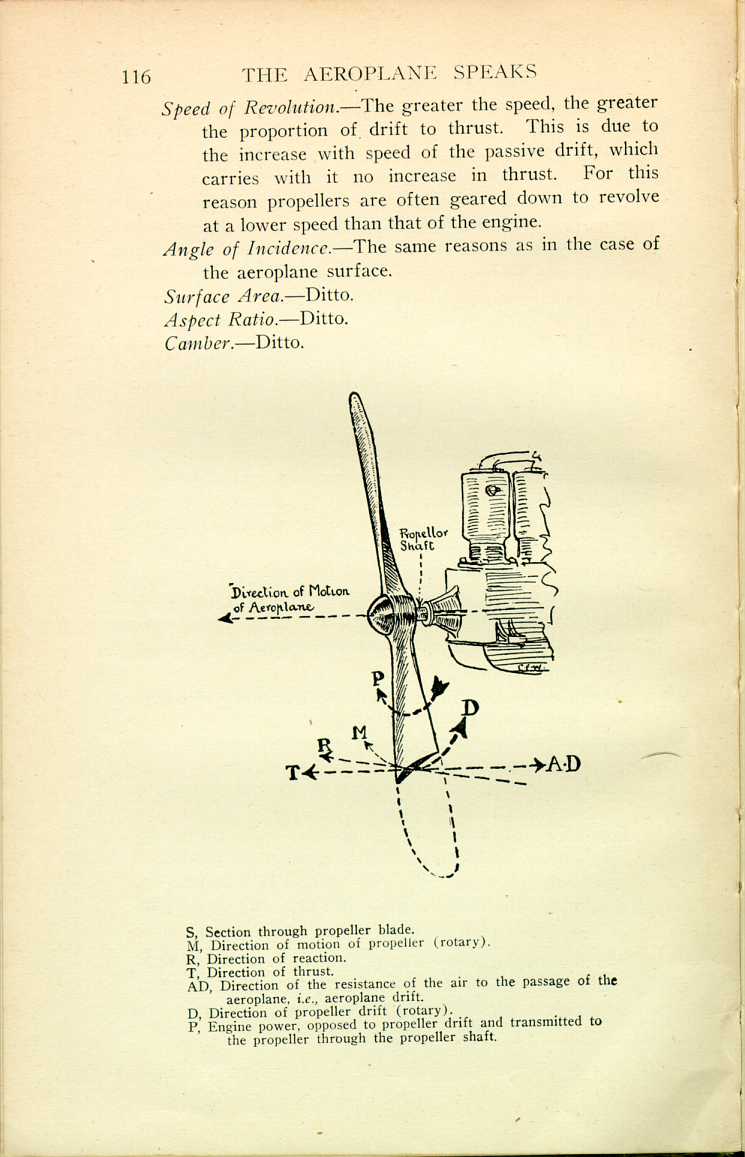|
CHAPTER IV
THE PROPELLER, OR "AIR-SCREW"
The Aeroplane Speaks | ||
The sole object of the propeller is to translate the power of the engine into thrust.
The propeller screws through the air, and its blades, being set at an angle inclined to the direction of motion, secure a reaction, as in the case of the aeroplane's lifting surface.
This reaction may be conveniently divided into two component parts or values, namely, Thrust and Drift (see illustration overleaf).
The Thrust is opposed to the Drift of the aeroplane, and must be equal and opposite to it at flying speed. If it falls off in power, then the flying speed must decrease to a velocity, at which the aeroplane drift equals the decreased thrust.
The Drift of the propeller may be conveniently divided into the following component values:
Active Drift, produced by the useful thrusting part of the propeller.
Passive Drift, produced by all the rest of the propeller, i.e., by its detrimental surface.
Skin Friction, produced by the friction of the air with roughnesses of surface.
Eddies attending the movement of the air caused by the action of the propeller.
Cavitation (very marked at excessive speed of revolution). A tendency of the propeller to produce a cavity or semi-vacuum in which it revolves, the thrust decreasing with increase of speed and cavitation.
Thrust-Drift Ratio.—The proportion of thrust to drift is of paramount importance, for it expresses the efficiency of the propeller. It is affected by the following factors:
Angle of Incidence.—The same reasons as in the case of the aeroplane surface.
Surface Area.—Ditto.
Aspect Ratio.—Ditto.
Camber.—Ditto.
In addition to the above factors there are, when it comes to actually designing a propeller, mechanical difficulties to consider. For instance, the blades must be of a certain strength and consequent thickness. That, in itself, limits the aspect ratio, for it will necessitate a chord long enough in proportion to the thickness to make a good camber possible. Again, the diameter of the propeller must be limited, having regard to the fact that greater diameters than those used to-day would not only result in excessive weight of construction, but would also necessitate a very high undercarriage to keep the propeller off the ground, and such undercarriage would not only produce excessive drift, but would also tend to make the aeroplane stand on its nose when alighting. The latter difficulty cannot be overcome by mounting the propeller higher, as the centre of its thrust must be approximately coincident with the centre of aeroplane drift.
|
CHAPTER IV
THE PROPELLER, OR "AIR-SCREW"
The Aeroplane Speaks | ||
